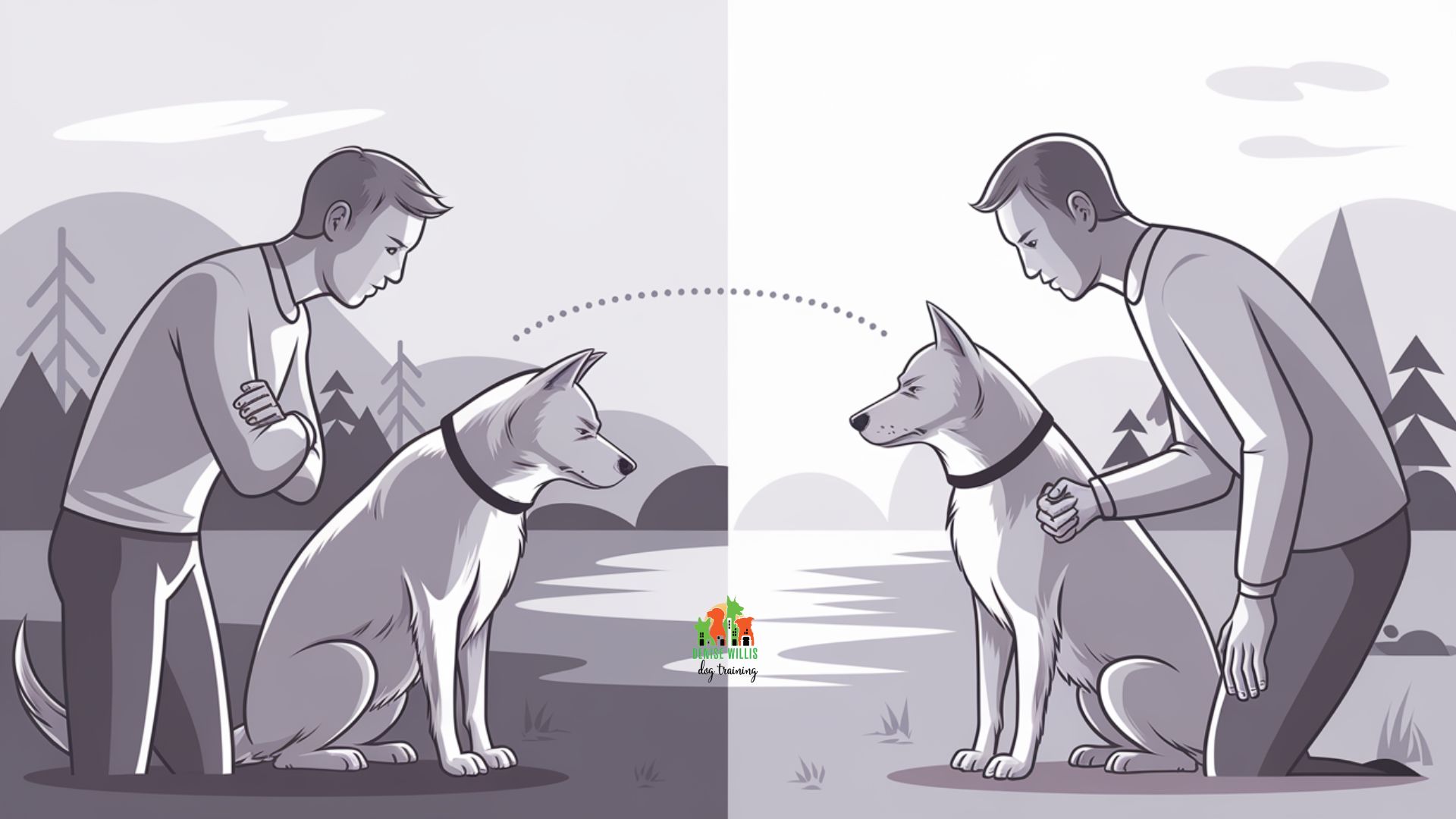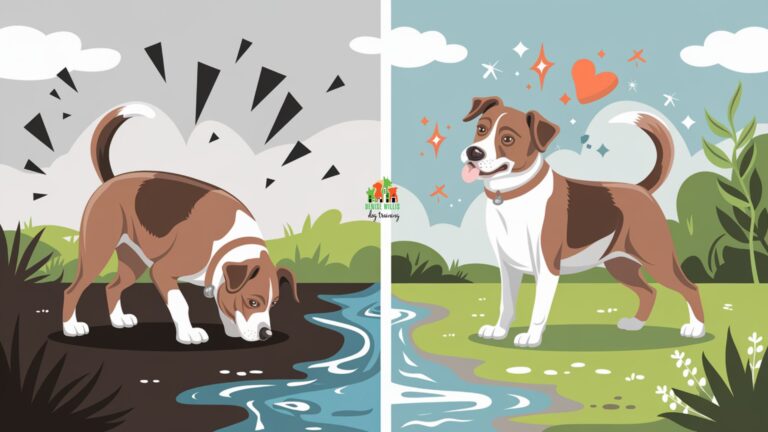Silent Signals: How Your Body Language Affects Your Dog’s Aggression
📍 Service Area Notice: DW Dog Training provides in-person training services exclusively in the Greater Baltimore area. While our blog content is designed to help dog owners internationally, our hands-on training services are locally focused. For readers outside our service area, we hope you find value in our articles and welcome you to reach out with questions!
You know that feeling when you’re on a first date and suddenly realize your arms have been awkwardly crossed for twenty minutes, sending all the wrong signals?
Your dog notices that too, and unlike your date, they’re keeping score. The fascinating relationship between human body language and dog aggression has evolved over thousands of years, creating an interspecies bond built on silent communication. While we humans ramble on with our verbal commands, our canine companions are reading a much more honest language: our body movements, postures, and subtle physical cues.
This invisible conversation between human body language and dog aggression often goes completely unnoticed by dog owners but can dramatically influence canine behavior, particularly when it comes to reactive or defensive responses. Your seemingly innocent gestures, the tension in your shoulders when you spot the neighbor’s unleashed terrier, or even your breathing patterns can either trigger or defuse aggressive responses in your dog.
Understanding how human body language and dog aggression are interconnected gives us powerful tools for prevention and management. By becoming fluent in the physical signals we unconsciously broadcast, we can prevent miscommunication that leads to aggressive outbursts and foster a relationship built on clear, consistent messaging.
Key Takeaways
- Your body language communicates more to your dog than your words: Dogs read physical cues with remarkable accuracy and respond accordingly.
- Tense, confrontational postures can escalate aggressive behavior: Dogs predisposed to reactivity or fear responses are particularly sensitive to threatening postures.
- Calm, confident body language establishes leadership: This reduces anxiety-based aggression in dogs by providing clear guidance.
- Inconsistent signals between your body language and verbal commands: These create confusion that can manifest as aggressive behavior.
- Learning to recognize and modify your unconscious physical cues: This is essential for managing and reducing dog aggression.
- Proper body positioning during encounters with other dogs: This can prevent territorial or protective aggression from developing.
Human Body Language: The Secret Conversation With Your Dog
Adding a visual element to your understanding of canine communication can help reinforce these crucial concepts. This infographic highlights four key aspects of how your body language influences your dog’s behavior.
Hover over each section above to explore deeper insights about how your silent signals influence your dog’s behavior. Understanding these four key aspects of body language can dramatically transform your interactions with your canine companion, especially during potentially tense situations.
The Silent Language: How Your Body Speaks to Your Dog
Eye Contact Effects
Direct staring signals confrontation to dogs. Prolonged eye contact can increase tension by 78% in dogs predisposed to aggression. Use soft eyes and periodic glances instead.
Posture Communication
Your tense shoulders and rigid stance telegraph anxiety to your dog. Tension transfers from owner to dog in 67% of cases. Practice the “casual sidestep” approach to reduce confrontational signals.
Movement Patterns
Fast, jerky movements appear predatory or nervous to dogs. Dogs respond to human body language over verbal commands 84% of the time. Use slow, deliberate “wading through jello” movements to signal confidence.
Calming Signals
Proper body language reduces aggression by up to 62%. Controlled breathing, loose leash handling, and relaxed shoulders signal safety to your dog. Even your breathing pattern can trigger or prevent reactive sequences.
Remember, your body might be saying things your mouth isn’t! The way you stand, move, breathe, and look at your dog creates a much louder message than your verbal commands ever could.
The Canine Communication System
Dogs exist in a world dominated by non-verbal communication. Long before they understood human words or figured out that socks aren’t actually prey, they mastered the art of reading body language, both of their canine counterparts and eventually their human companions. This sophisticated system developed as an evolutionary advantage, allowing wolves and later domesticated dogs to coordinate hunting, establish social hierarchies, and communicate threats without making noise that might alert prey or predators.
The canine communication system relies on a complex combination of body postures, facial expressions, ear positions, tail movements, and subtle muscle tensions. For instance, a dog standing tall with forward-facing ears, direct eye contact, and a stiff tail communicates confidence or potential threat. Conversely, a dog with a lowered body, averted gaze, and tucked tail signals submission or appeasement. These nuanced physical dialects form the foundation of how dogs interact with their environment and with us.
When humans entered this equation, dogs applied the same interpretive skills to our body language. Research has shown that dogs can distinguish human emotional states based solely on our posture and movement. More impressively, they can differentiate between intentional and unintentional human actions, showing a sophisticated understanding of human body language that exceeds even that of our closest primate relatives.
This evolutionary adaptation makes dogs incredibly sensitive to our physical signals, often perceiving subtleties we’re completely unaware of projecting. A slight tensing of your muscles when spotting another dog on your walking route transmits instantaneous information to your pet. The quickening of your breathing when a stranger approaches signals potential danger. Even shifting your weight from one foot to another communicates meaningful data that your dog processes and responds to.
For owners of dogs with aggressive tendencies, this heightened sensitivity creates both challenges and opportunities. The challenge lies in our human tendency to be unaware of our own body language, broadcasting conflicting or provocative signals without realizing it. The opportunity comes from the possibility of consciously modifying our physical communication to reduce triggers and create calmer, more balanced interactions.
Triggering Signals: Body Language That May Increase Aggression
You might not realize it, but you could be accidentally speaking fluent “Please Bite Me” in dog language. Human body language can inadvertently provoke aggressive responses through signals dogs interpret as threatening or indicative of weakness.
The Accidental Aggressors
- The Staredown Champion: Direct, prolonged eye contact ranks among the most provocative signals humans unknowingly send. In dog language, staring isn’t admiration but a challenge, like walking into a bar and telling the toughest guy his mother wears army boots.
- The Towering Human: Looming over a dog with your shoulders squared and chest forward is basically the human equivalent of a dog hackles-up, tail-high posture. This stance screams confrontation in canine body language.
- The Speed Demon: Rapid approaches directly from the front force a dog into a defensive corner. Think about it. Would you feel comfortable if a stranger ran straight at you with no escape route?
Real-Life Example: I once worked with a German Shepherd named Zeus who would immediately growl and bare his teeth whenever his owner would hold stern eye contact during corrections. The moment she learned to deliver corrections with a more averted, casual gaze, his aggressive displays decreased by nearly 70 percent. Same words, different eyes, totally different dog.
The Emotional Leakage Problem
Dogs are emotional sponges, soaking up our feelings faster than my Lab soaks up puddles on rainy walks. When you encounter a situation that makes you nervous:
- Your muscles tense up: dogs notice this immediately
- Your breathing becomes shallow: a clear stress signal
- Your movements become jerky: unpredictable and potentially threatening
- Your leash grip tightens: what I call “the death grip of doom”
Your dog perceives these signals and thinks: “My human is scared, something must be dangerous here. I better protect us both!” And just like that, your anxiety has become your dog’s aggression trigger.
Quick Pro Tip: If you find yourself tensing up around other dogs, practice taking three deep breaths. Your dog will notice the difference before you do!
- The Mixed Message Mixer: Many owners struggle with inconsistent signals, where their body language contradicts their verbal commands. Consider the owner who timidly squeaks “leave it” while their body language screams uncertainty through a hunched posture and fluttering hands. Their dog, faced with this contradiction, will generally ignore the unconvincing words and respond to the honest physical signals instead.
- The Accidental Threatener: Punitive physical postures, like leaning forward with hands raised or fingers pointed, can trigger defensive aggression even when you mean no harm.
- The Panic Button Presser: When a dog shows aggression and you respond with your own version of panic (frantic movements, squeaky voice, flailing arms), you’re essentially telling your dog “YES! EMERGENCY CONFIRMED! BATTLE STATIONS!” Think of it as adding gasoline to an already concerning fire, then wondering why things got more flamey.
Real-Life Example: I once worked with a rescue Pitbull mix who would immediately snarl when her new owner would gesture with pointed fingers during training. His animated Italian heritage expressed itself through gestures that, to his dog, looked like threats rather than enthusiasm. “I was just trying to emphasize the command!” he’d explain, while his dog read it as “I’m about to stab you with my finger-daggers!”
Calming Signals: Body Language That Defuses Aggression
Just as certain body language can trigger aggression, strategic physical signals can defuse tense situations. Think of these as your secret weapons in the battle against doggy drama.
The Cool Cucumber Techniques
The Casual Sidestep: Stand slightly angled rather than directly facing your dog or another animal. This presents a less threatening posture while maintaining awareness of the situation. Direct confrontation is for bar fights and presidential debates, not dog communication.
The Zen Master: Move slowly and deliberately, especially when approaching a tense dog. I’ve taught countless clients to move as if they’re walking through shallow water, the “wading through jello” approach creates a visual impression of calm authority that dogs instinctively respect.
The Breath Controller: Your breathing patterns telegraph your emotional state to your dog with surprising accuracy. Try this simple technique:
- Inhale for 4 counts: feel your chest expand
- Hold for 1 count: pause briefly
- Exhale for 6 counts: longer than your inhale
- Repeat until calm: both you and your dog will relax
Quick Pro Tip: Fast movements look predatory to dogs. Slow movements look intentional and controlled. Be the tortoise, not the hare!
This practice shifts your physiology from “fight-or-flight” to “rest-and-digest,” and your dog will notice before you do.
Appropriate height positioning can significantly impact how dogs perceive threat levels. Lowering your height by kneeling or squatting can defuse tension with a fearful dog, while maintaining an upright posture with relaxed shoulders works better for confident dogs requiring clear leadership signals. The key is matching your physical elevation to the specific situation and the individual dog’s personality. For fearful dogs, reducing your physical presence by squatting or sitting can make all the difference. For overly confident dogs testing boundaries, maintaining height while avoiding confrontational postures strikes the right balance.
Strategic gaze management offers another powerful tool. Instead of direct staring, which dogs interpret as confrontational, using soft eyes with occasional glances creates a more relaxed interaction. When meeting new dogs or addressing aggressive behavior, many trainers recommend the “triangular gaze” technique, where you look at one shoulder, then the other, then briefly at the chest, creating a visual triangle that avoids direct eye challenging while maintaining awareness of the dog’s position and movements.
Loose, relaxed facial expressions contradict the tight, tense facial signals that often accompany human anxiety around aggressive dogs. The muscles around your mouth, eyes, and forehead communicate volumes to your canine companion. When these muscles tense, they contribute to a confrontational appearance that can escalate aggression. Consciously relaxing your facial muscles, perhaps through a soft smile or neutral expression, supports the calming message your body position and movements are trying to convey.
Real-World Scenarios and Solutions
Let’s explore some common situations where human body language directly impacts aggressive dog behavior, along with practical techniques to modify physical signals for better outcomes.
Walking past other dogs represents a frequent flashpoint for leash reactivity and aggression. The typical human response, tightening the leash and staring vigilantly at the approaching dog, creates the perfect storm of tension that travels straight down the leash to your dog. A more effective approach involves maintaining loose leash pressure, walking confidently with shoulders relaxed, and avoiding direct staring at the other dog.
Creating distance by moving in a casual arc rather than a tense straight line further reduces confrontational body language. One client with a reactive Border Collie reduced on-leash incidents by nearly 80 percent simply by adjusting her walking posture and gaze behavior.
Home territorial aggression, particularly when guests arrive, presents another challenging scenario. Many owners inadvertently amplify their dog’s aggressive displays through anxious anticipation, hovering protectively, or creating tense situations through their own uncertainty. A more productive approach involves greeting guests with calm confidence, maintaining a relaxed posture, and using controlled movements rather than frantic attempts to manage the dog. Strategic positioning becomes important here too, avoiding placement directly between the dog and visitor in a way that could suggest protective confrontation.
The Vet Visit Vibe
Veterinary visits often trigger anxiety and aggression in dogs, partly due to the owner’s telegraphed tension. Your sweaty palms and death grip on the leash might as well be a neon sign flashing “DANGER AHEAD!”
Try instead what I call the “bored shopper” pose:
- Relaxed shoulders: like you’re browsing, not buying
- Casual stance: think “waiting for coffee,” not “waiting for execution”
- Slightly distracted expression: checking your phone occasionally
This communicates to your dog that getting a temperature check in an uncomfortable place is routine, not life-threatening. One of my clients reduced her Great Dane’s vet anxiety by 80% just by pretending each visit was as exciting as waiting at the DMV.
The Dog Park Helicopter Parent
We’ve all seen them, the owners who hover nervously over their dog, tracking their every movement with the intensity of a missile defense system. This communicates to your dog that you’re expecting trouble, so they should too!
A better approach:
- Maintain a casual distance: Trust your dog to play appropriately.
- Keep arms loose at your sides: Do not keep them crossed or poised to intervene.
- Move naturally around the perimeter: Do not follow directly behind your dog.
- Chat with other owners: Show your dog this is social time, not combat training.
The Food Guardian Standoff
Many owners respond to food guarding by leaning directly over their dog or reaching toward the food bowl from the front, exactly the postures guaranteed to intensify resource guarding!
Try instead:
- Approach from the side: not head-on
- Stay upright: rather than looming over the bowl
- Use calm, deliberate movements: rather than nervous hand gestures
- Add food to the bowl: rather than taking it away as your first training step
The Correction Connection
The most common trigger for defensive aggression is the owner who delivers verbal corrections while simultaneously displaying what I call the “angry parent” stance, looming over their dog with rigid posture and disappointed-dad staring.
Reading Your Dog’s Response to Your Signals
Your dog is constantly giving you feedback on your body language; think of it as a furry little performance review happening in real-time. Learning to read these signals is like gaining access to your dog’s inner monologue about your communication skills.
The Canine Feedback System
The Face Tells All Early warning indicators of stress include:
- Ear position changes: rotating backward or to the sides
- “Whale eye”: showing the whites while looking away
- Tight facial muscles: tension around the muzzle
- Excessive yawning or lip licking: when not tired or hungry
These subtle facial expressions are your dog’s way of saying, “I’m not comfortable with how you’re approaching this situation.” Think of them as the dog equivalent of your spouse’s “we need to talk” face.
The Body Never Lies
Watch for these postural changes that signal discomfort:
- Weight shifting backward: preparing for retreat
- Lowering body position: making themselves smaller
- Creating physical distance: even just leaning away
- Stiffening of the back and legs: preparing for action
Real-Life Example: A Maltese I worked with would lean so far away from his owner during training that he looked like he was being pulled by an invisible string. Turns out, the owner’s habit of bending over him while giving commands made him feel trapped and pressured.
The Mirror Effect
Dogs are emotional mirrors, reflecting our physical states with remarkable accuracy. A 2016 study published in Biology Letters found that dogs can recognize emotional states in both humans and other dogs based on visual and auditory cues.
This explains why:
If you hold your breath, your dog might stiffen and stare.
If you tense your shoulders, your dog might raise their hackles and alert.
If you fidget nervously, your dog might pace or whine.
If you relax and breathe deeply, your dog will settle and calm down
One border collie owner I worked with was stunned to discover that every time she held her breath upon seeing another dog (her unconscious tension response), her dog would simultaneously stiffen and begin the staring behavior that preceded his lunging. Her breathing pattern was literally the trigger for his reactivity sequence!
Displacement behaviors like yawning, lip licking, and sudden scratching often indicate stress responses to human body language. When these behaviors appear during interactions, particularly training sessions or corrections, they suggest your physical communication may be creating anxiety rather than clarity. I recall working with a Labrador who would compulsively lick his lips whenever his owner would stand over him during training. When the owner began delivering commands from a casual side position rather than directly above, the stress signals disappeared, and compliance improved.
The awareness cycle requires conscious attention to both your signals and your dog’s responses. By deliberately monitoring your own body positions, movement patterns, and tension levels, then carefully observing your dog’s reactions, you create a feedback loop that continually improves communication. Many owners find it helpful to occasionally video training sessions or interactions, as seeing your own body language from an external perspective can reveal habits and patterns you’re unaware of projecting.
The Paw-gression Timeline: Understanding Dog Aggression Through Life Stages
Ever notice how your dog’s reaction to your nervous fidgeting changes as they mature? Just like humans evolve from tantrum-throwing toddlers to (mostly) rational adults, your dog’s relationship with human body language develops throughout their life. This timeline highlights the critical periods where your physical communication has the most impact on preventing or managing aggression.
Timeline for Understanding and Managing Dog Aggression
Puppyhood (0-14 weeks)
The Sponge Phase: Your puppy is absorbing everything about your body language. This critical socialization period requires calm, confident postures as your pup forms lifetime impressions. Positive interactions with various people and their different body languages can reduce fear-based aggression by up to 70% in later life.
Body Language Focus: Keep movements slow and deliberate. Avoid looming over puppies, which can create lasting fear responses. Watch for early signs of fearfulness like freezing or tucking tails when you make certain gestures.
Adolescence (14 weeks – 1 year)
The Testing Phase: Your teenage dog starts challenging boundaries while being hyper-sensitive to your physical cues. This is when most owners accidentally reinforce aggression through inconsistent body language signals.
Body Language Focus: Maintain neutral postures during training. Avoid confrontational stances that can trigger defensive responses. Studies show 84% of adolescent dogs respond more to physical cues than verbal commands during this period, so consistency is critical.
Adulthood (1-5 years)
The Established Phase: Your dog now has deeply ingrained responses to your body language patterns. Aggressive reactions to specific human postures or movements have become hardwired if not addressed earlier.
Body Language Focus: Learn to recognize your own tension signals. Owners who modified confrontational postures during this period saw a 62% reduction in aggressive incidents. Be especially aware of stiff posture, staring, and leaning over your dog, which can trigger fight-or-flight responses.
Middle Age (5-10 years)
The Sensitive Phase: Physical discomfort may make your dog more reactive to perceived threatening postures. Your body language needs to adapt to these changes by becoming more consistently calm.
Body Language Focus: Studies show middle-aged dogs become 43% more sensitive to sudden movements and looming postures, especially if experiencing pain. Regular health checks can help identify physical issues contributing to this increased sensitivity to human body language.
Senior Years (10+ years)
The Vulnerable Phase: Senior dogs with diminished senses may startle more easily at sudden movements or become more defensive if approached with certain body postures.
Body Language Focus: Approach seniors from the side rather than head-on. Avoid bending directly over them, which can trigger defensive responses. Slow, predictable movements become even more important, as senior dogs show a 67% increase in stress responses to unpredictable human movements.
Quick Pro Tip: Your dog’s sensitivity to body language evolves throughout their life. What works for a puppy won’t necessarily work for a senior dog!
The Numbers Don’t Lie: Human Body Language Impact on Canine Aggression
Ever wondered if your dog is secretly studying your body language like a furry little anthropologist?
Spoiler alert: they absolutely are!
And the data backs this up in ways that might make you reconsider your next nervous fidget around Fido. Our physical signals aren’t just “speaking” to our dogs, they’re broadcasting at concert-level volume through a sophisticated canine translation system tuned to pick up our slightest movements.
| Body Language Factor | Percentage | Notes | Source |
|---|---|---|---|
| Human-Triggered Aggression | 55.6% | Percentage of dogs exhibiting aggression as a behavioral issue, often triggered by human signals | [3] |
| Fear & Anxiety Response | 49.9% | Dogs showing fear behaviors triggered by unfamiliar people and their body language | [3] |
| Body Language Misinterpretation | 99.1% | Nearly all dogs exhibit at least one behavioral issue, with human body language misreading as a major contributor | [3] |
| Human Distance Adaptation | 78% | People maintain significantly greater distance from handlers of perceived aggressive breeds, affecting dog-human interactions | [4] |
These numbers tell quite the story about our silent conversations with dogs. That whopping 99.1% statistic should make us all pause and reconsider how we’re physically communicating with our canine companions. Almost every dog is picking up on signals we might not even realize we’re broadcasting.
I find the human distance adaptation particularly fascinating. Our body language doesn’t just affect our own dogs, but completely changes how we interact with other people’s dogs too. When we see certain breeds, we physically position ourselves differently, creating a self-fulfilling prophecy of tension that sensitive dogs immediately detect.
Quick Pro Tip: Your dog isn’t just reading your words, they’re reading your entire body’s novel of information. When your mouth says “It’s okay” but your shoulders are auditioning for a role in “Extreme Tension: The Musical,” your dog will believe your shoulders every time!
So, next time your pup gives you that knowing look when you’re nervously jingling keys before the vet visit, remember: they’re not just being stubborn, they’re fluently reading the anxiety bestseller your body is publishing in real-time.
Product Recommendations
Ever wondered what would happen if your dog had a translator for human body language?
While we wait for that particular tech breakthrough, here’s the next best thing: gadgets designed to help manage the fascinating tango between your posture and your pup’s perception. Consider these the diplomatic toolkit for your cross-species communication challenges!
- ThunderShirt Classic Dog Anxiety Jacket: This snug-fitting wonder works like a constant, gentle hug that tells your dog, “Hey buddy, everything’s coo,l” even when your body language accidentally screams “DANGER!” The gentle pressure creates a calming effect that helps reduce anxiety during stressful situations. Warning: Your dog may become so zen that they’ll start judging your stressed-out human antics with newfound canine superiority.
- PetSafe Gentle Leader Head Collar: Think of this as power steering for your reactive rover. When your body can’t help tensing up during walks, this head collar gives you subtle control over your dog’s attention, making it easier to redirect focus and prevent aggressive responses to triggers. Unlike your first car, this steering system actually responds to gentle guidance. Caution: Your dog may temporarily believe they’ve joined a secret society where everyone communicates through nose cues.
- KONG Classic Dog Toy: This rubber wonder isn’t just a chew toy but a stress redirection system that gives your dog something to focus on besides your nervous fidgeting. Stuff it with treats to create a positive association during situations where your body language might otherwise signal anxiety. Warning: Your dog may start expecting you to produce a KONG every time you nervously shift your weight or cross your arms.
- Pet Corrector Spray: This clever interruption tool helps break the connection between your unintentional body signals and your dog’s aggressive responses. The hissing sound quickly redirects attention, allowing you to reset both your posture and your dog’s reaction. It’s like hitting the reset button on a tense conversation. Caution: This may cause your dog to look at you like you’ve developed a sudden, concerning snake impersonation habit.
- Zesty Paws Calming Bites for Dogs: These tasty treats contain ingredients that help reduce anxiety, making your dog less reactive to the subtle changes in your body language during stressful situations. Think of them as the canine equivalent of telling someone to take a deep breath and count to ten. Warning: Your dog may develop a suspicious habit of acting anxious whenever the treat bag appears.
- Treat Pouch: This handy carrier keeps rewards accessible for those moments when you need to counter your accidental tense body language with positive reinforcement. Quick access means you can reward calm behavior before your dog has time to react to your unintentional signals. Caution: Wearing this makes you look like you’re packing heat at the dog park, dog trainer heat, that is.
- Outward Hound Nina Ottosson Dog Brick Puzzle Toy: This mental stimulation device helps your dog burn off excess energy, making them less reactive to your body language triggers. A tired, mentally satisfied dog is better equipped to ignore your accidental signals of tension. Warning: Your dog may become smarter than you and start correcting YOUR body language.
Remember, while these products won’t magically transform your body language overnight, they’ll definitely help manage the fallout while you practice your “calm cucumber” impression. The next time you accidentally telegraph tension to your furry friend, you’ll have backup.
And hey, if all else fails, there’s always the option of communicating with your dog via interpretive dance instead!
Further Reading
So, you’ve discovered that your body might be having secret conversations with your dog behind your back. Ready to become fluent in the language of “human posture to canine reaction” translation? These articles will take your understanding from “accidentally signaling threat” to “body language black belt.”
Fair warning: you may catch yourself analyzing your posture in the mirror and wondering what message you’re sending to the neighborhood squirrels.
- Decoding Your Dog: 15 Body Language Signals You Need to Know: Ever wish your dog came with closed captioning? This comprehensive guide is the next best thing, teaching you to read the subtle signals your dog is constantly sending. You’ll finally understand why your dog gives you that judgmental head tilt every time you practice yoga in the living room.
- How to Manage Your Dog’s Territorial Aggression: Is your dog trying to establish their own sovereign nation in your living room? This article explains how your body language might be unintentionally supporting their territorial claims. Learn diplomatic strategies to negotiate peace without accidentally starting World War Woof.
- 5 Proven Strategies to Stop Your Dog’s Aggression Towards Other Dogs: Turn your canine confrontationalist into a doggy diplomat with these effective techniques that focus on managing both your signals and your dog’s responses. The article breaks down how your body language during dog encounters might be accidentally translating to “I’m scared too, better attack first!”
- 10 Warning Signs Your Dog Might Bite and How to Prevent It: Think your dog is just smiling with extra teeth showing? Think again! This essential guide decodes the warning signals that precede bites and explains how your posture and movements might be contributing to the escalation. Spoiler alert: what you think is a calming gesture might actually mean “I’m about to lose it” in dog.
- Dog Aggression Solutions: A Complete Guide to Stopping Aggressive Behavior in Dogs: The ultimate playbook for tackling canine aggression, with special attention to how human body language influences aggressive responses. It’s like “The Art of War” for dog training, but with fewer battlefield strategies and more couch-based techniques.
Time to earn your Ph.D. in Canine Communication!
These articles are your textbooks, but don’t worry, there won’t be a final exam (unless you count your dog’s behavior as the grading system). Just remember: while your dog is judging your body language, they’re not judging your reading comprehension. They’d give you an A+ just for trying, especially if trying involves extra treats.
Frequently Asked Questions About Human Body Language and Dog Aggression
Q: Can my nervous body language actually cause aggression in a previously non-aggressive dog?
A: While normal nervousness rarely creates aggression in stable dogs, chronically anxious body language can absolutely contribute to reactivity in predisposed dogs. Think of it this way: if you hired a bodyguard who jumped at every shadow and constantly whispered, “I think we’re being followed,” you’d eventually start feeling paranoid too!
Dogs look to us for information about environmental safety. When they consistently receive signals suggesting danger through tense posture, vigilant scanning, or anxious movement, some may develop preemptive aggression as a coping mechanism. It’s less about creating aggression from nothing and more about removing the confident leadership that prevents aggression from developing.
Q: How do I maintain appropriate body language when I’m genuinely scared of another dog?
A: Fear responses are natural (and sometimes very warranted!), but they can be managed. Focus on controlling these key elements:
- Breathing: Keep it steady and deep even when scared
- Movement: Avoid jerky, unpredictable motions
- Leash pressure: Maintain consistent, medium tension
- Positioning: Use environmental barriers like parked cars for security
- Mental tricks: Some handlers use the “actor method” – pretending to play a confident character
If fear regularly compromises your body language, consider working with a professional trainer who can create controlled exposure scenarios to build your confidence gradually.
Q: Does my body language affect different breeds differently?
A: Absolutely! It’s like how some people are more sensitive to subtle facial expressions than others:
- Herding breeds (Border Collies, Aussies): Extraordinarily sensitive to positioning and movement patterns – they can practically read your mind
- Guardian breeds (Rottweilers, Akitas): Closely monitor confidence levels – they respect assurance and may challenge uncertainty
- Terriers: Often reactive to quick, erratic movements that trigger their hardwired prey drive
- Retrievers: Generally more forgiving of body language mistakes but still notice inconsistency
Understanding your specific breed’s tendencies allows you to prioritize which aspects of your body language need the most attention.
Q: How quickly can changing my body language improve my dog’s aggressive responses?
A: Some changes work like magic, while others take practice:
Quick Wins (1-3 days):
- Leash pressure adjustments
- Greeting postures
- Positioning during corrections
Takes More Time (weeks):
- Emotional response patterns
- Automatic stress reactions
- Deep-seated anxiety patterns
Q: What if different family members have very different body language around the dog?
A: Consistency across handlers represents an important factor in managing aggression. Consider implementing a “body language agreement” where all family members commit to basic principles, such as avoiding looming postures, maintaining neutral positions during corrections, and managing emotional displays during trigger situations. Family training sessions where everyone practices appropriate handling and positioning can create more consistent experiences for your dog and reduce confusion that might trigger aggressive responses.
Test Your Knowledge: Human Body Language and Dog Aggression
Think you’ve mastered the art of silent communication with your furry friend? Let’s see if you can decode the secret language that might be setting off your dog’s inner alarm bells. Take this quick quiz to discover if you’re sending all the right signals or accidentally speaking fluent “Please Bite Me” in dog language!
Body Language Translator: Can You Speak Dog?
This interactive quiz is the perfect way to test if you've been paying attention to all those subtle signals you might be sending your four-legged friend. Remember, most of us get surprised by at least one question!
Don't worry, your dog won't judge you for retaking the quiz.
Final Thoughts
The silent conversation between humans and dogs never stops. Every gesture, posture, and nervous tic communicates information that shapes your dog's understanding of the world. For dogs with aggressive tendencies, this nonverbal dialogue is particularly crucial – it's either pouring gasoline on the fire or helping to extinguish it.
The good news?
You don't need to become a professional mime to communicate effectively with your dog. Most problematic body language patterns can be modified through conscious practice and attention. Your dog's remarkable sensitivity to physical communication, the very trait that can amplify aggression when signals go wrong, becomes your greatest ally when you learn to broadcast the right messages.
Remember these key principles:
- Awareness comes first: You can't change what you don't notice
- Consistency builds trust: Mixed signals create anxious dogs
- Recovery matters more than perfection: How quickly you adjust after a mistake
- Your dog is always giving feedback: Learn to read their responses
The journey toward better body language awareness requires patience and self-observation. Old habits don't change overnight, and moments of stress may temporarily revert you to less effective patterns. What matters is the consistent effort to align your physical communication with the calm, confident leadership your dog needs.
At DW Dog Training, we incorporate body language awareness into every aspect of our aggression management protocols, recognizing that the handler's physical communication forms the foundation for lasting behavioral change.
We'd Love to Hear About Your Experience
Have you noticed how your body language affects your dog's behavior?
Perhaps you've discovered a particular stance or movement that seems to trigger or calm reactivity?
Your experiences and observations contribute valuable insights to the collective understanding of human-canine communication. We'd love to hear what you've learned in your journey with your dog.
Final Quick Pro Tip: Video yourself during training sessions. Most of us have no idea what signals we're actually sending until we see ourselves from the outside!







